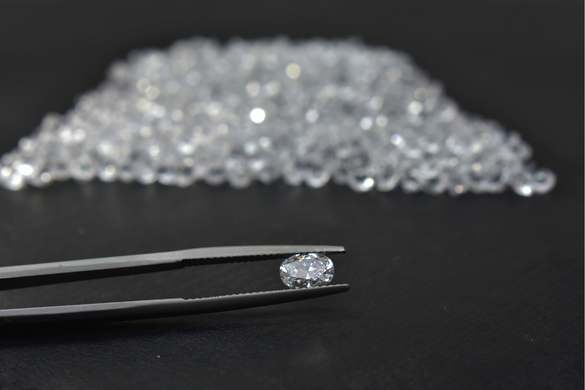Diamonds in Simulants

When it comes to diamond stimulants and substitutes many of us are left in a daze of confusion and hype created around several materials that replace the popular gemstone in jewellery. Here is an account that puts to rest the differences between diamond stimulants and lab-grown diamonds while shedding some light on the different options available out there.
The first and most important fact is to realise the difference between diamond stimulants and lab-grown diamonds. Simulants are man-made or naturally occurring materials that are used in place of diamonds, they have different optical, chemical and physical properties from diamonds. Moissanite, cubic zirconia, crystal, rock crystal, white sapphire and white topaz have all been used as diamond substitutes over the years.
On the other hand, lab-grown diamonds are diamonds that have been created in a laboratory and have the same physical chemical and optical properties of naturally occurring diamonds. The term synthetic diamond too at times can be misleading. The term can lead one to erroneously think the diamonds are fake, artificial or stimulants. The Federal Trade Commission (FTC) in the US has acknowledged that the term synthetic could mislead consumers when describing man-made diamonds. According to the FTC, ""the term is a potentially confusing term, i.e., consumers associate synthetic gemstones with imitation stones."" The body has determined that ""these other terms ('laboratory-created,' 'laboratory-grown,' '[manufacturer-name]-created') would more clearly communicate the nature of the stone.""
Moissanite is almost identical to diamond with a hardness of 9.25 (or 9.5 by some accounts) on Moh’s scale. First discovered in 1893 by a French scientist named Henri Moissan, this material originated as a meteorite that fell to earth. However, natural moissanite is incredibly rare; instead it is now is a widely manufactured mineral composed of silicon carbide. Moissanite’s faceting pattern is different and it is easily distinguishable from diamond by its heightened brilliance. This effect increases in sunlight and as stones increase in size. Even in terms of colour moissanites termed “colourless” may project a yellow or greyish hue under certain lights and this effect becomes more noticeable with increase in size.
Natural zircon is distinguishable from a diamond as it displays double refraction causing it to have a “fuzzy” appearance, it is also sometimes possible to tell the two apart by the amount of wear and tear of the edges of the zircon’s facets, as zircon is much softer than diamond with a hardness of around 7 – 7.5.
Cubic Zirconia (CZ) is a man-made material measuring around 8.5 on Moh’s scale that has been on the market since 1976. Although not as hard as diamond CZ is generally thought to be compositionally superior to diamond due to its greater brilliance and sparkle as well as it's entirely colourless and blemish-free properties. Even so, common opinion also concurs that CZ is simply ‘too perfect’ and that it looks artificial even to the naked eye. Because of this, some CZ manufacturers have started producing the gem with coloured tints and inclusions so that it more closely resembles diamond.
Strontium titanate is a colourless manmade material that became a popular diamond simulant in the 1950s. However, its dispersion (the optical property that creates fire in a faceted gemstone) is over four times greater than diamond and makes it easily distinguishable from the real deal under 10X magnification.
YAG and GGG were two diamond stimulants that emerged in the 1960s. Yttrium aluminium garnet (YAG) and its “cousin” gadolinium gallium garnet (GGG) were widely manufactured but today have been rendered obsolete by the popularity of cubic zirconia as a diamond substitute.
Apart from these, crystal, rock crystal, white topaz, synthetic rutile, synthetic and natural white sapphire have been used as diamond simulants over the years but are now more or less easily identifiable with advanced gemmology equipment and identifying techniques.
Lab-grown diamonds date back to the early 1970s, when General Electric produced the first gem-quality synthetic diamond crystals.
High Pressure High Temperature (HPHT) process and the Carbon Vapour Deposition (CVD) process are the two production methods widely used for producing lab-grown diamonds today.
The HPHT process uses graphite or diamond 'powder' in a high pressure high temperature environment, in the presence of a metal solvent and one or several small diamond crystals to act as seeds. This results in diamonds that can grow as large as 10 carats, generally brown or yellow in colour due to the presence of nitrogen.
In the CVD process, graphite is vapourised in a vacuum chamber with a diamond crystal. The carbon vapour gets deposited on the seed crystal and the diamond ‘grows.’ Diamonds produced through this method are very pure and free of distortions - and thus colourless, but the crystals are small (below 1 ct of cut gem) and may have graphite inclusions.
Distinguishing a synthetic from a natural diamond is quite challenging, and can authoritatively be accomplished only in a well equipped gemmological laboratory. HPHT stones sometimes show traces of the metal solvent which are a tell tale sign of their origin. However these extremely minute and beyond the scope of a 10X loupe or even a microscope. Lab-grown diamonds show distinct UV and IR absorption behaviour, and infrared Raman spectrography is the only reliable method to distinguish them from their natural counterparts.

